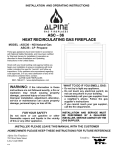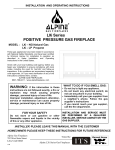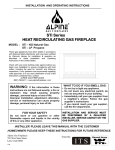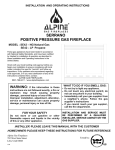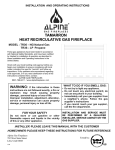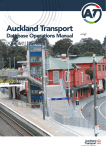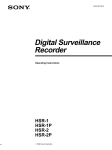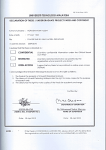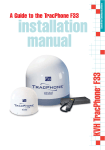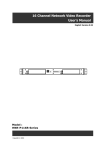Download Alpine ASC42 Operating instructions
Transcript
INSTALLATION AND OPERATING INSTRUCTIONS ASC – 42 HEAT RECIRCULATING GAS FIREPLACE MODEL : ASC42 – NG Natural Gas ASC42 – LP Propane These gas appliances have been tested in accordance with National Safety Standards, and have been certified by Warnock Hersey for installation & operation as described in these Installation and Operating Instructions in the United States. Check with your local building code agency before you begin your installation to ensure compliance with local codes, including the need for “permits” and follow-up inspections. If any problems are encountered regarding code approvals, or if you need clarification of any of the instructions contained here, contact: ALPINE GAS FIREPLACES #801-768-8411 / www.alpinefireplaces. com WARNING: If the information in these instructions are not followed exactly, a fire or explosion may result causing property damage , personal injury or loss of life. Improper installation, adjustment, alteration, service or maintenance can cause property damage, personal injury or loss of life. FOR YOUR SAFETY Do not store or use gasoline or other flammable vapors and liquids in the vicinity of this or any other appliance. WHAT TO DO IF YOU SMELL GAS: • Do not try to light any appliance. • Do not touch any electrical switch; do not use any phone in your building. • Immediately call your gas supplier from a neighbor’s phone. Follow the gas supplier’s instructions • If you cannot reach your gas supplier, call the fire department. INSTALLATION AND SERVICE MUST BE PERFORMED BY A QUALIFIED INSTALLER, SERVICE AGENCY OR THE GAS SUPPLIER. INSTALLER: PLEASE LEAVE THIS MANUAL WITH THE CUSTOMER HOMEOWNER: PLEASE KEEP THESE INSTRUCTIONS FOR FUTURE REFERENCE Alpine Gas Fireplaces 782 West State Street Lehi, Utah 84043 12/06 Tested by: TABLE OF CONTENTS SAFETY INFORMATION Safety Label ........................................2 Before Starting....................................3 General Safety Information ................3 System Specifications.........................4 Derating the Burner ............................4 OPERATING INSTRUCTIONS Operation Instruction Plate .............. 20 Lighting Procedure........................... 21 Control Valve Operation .................. 21 Shutdown Procedure ........................ 21 FIREPLACE MAINTENANCE INSTALLATION REQUIREMENTS Locating the Fireplace ........................4 Gas Line Installation...........................5 Clearances...........................................5 Mantel Clearances ..............................5 Hearth Materials .................................5 Framing and Finishing ........................6 VENTING Venting Planning ................................7 Venting Components List ...................7 Venting Chart / Direct Vent................8 Horizontal /Vertical Terminations ......9 Horizontal Venting Installation ........11 Vertical Venting Installation.............12 Maintenance Instructions .............. 21 Cleaning Brass Trims....................... 21 Cleaning the Glass............................ 22 Cleaning the Logs ............................ 22 SERVICE Log Replacement ............................. 22 Inspecting the Pilot........................... 22 Replacement Parts List..................... 23 TROUBLESHOOTING GUIDE Gas Control System.......................... 24 ELECTRICAL SYSTEM Electrical System Installation ...........13 Millivolt System ...............................14 INSTALLATION INSTRUCTIONS Securing the Fireplace ......................14 Installing the Venting .......................14 Aeration Adjustment.........................17 Log Installation.................................18 Door Assembly Installation .............19 Remote Control (Optional) ...............19 Wall Thermostat (Optional)..............19 Alpine Supply Company 42 Direct Vent Gas Fireplace 1 2 WC WC WC DMS BTU/h BTU/h Ft Model ASC42-LP Model ASC42-NG Minimum supply pressure 11” Manifold pressure high 10.0” Manifold pressure low 5.8” Orifice Size # 55 Minimum input 16,000 Maximum input 23,000 Altitude 2500 – 6500 PROPANE : Series ASC42-LP WC WC WC DMS BTU/h BTU/h Ft Field Converted Put Label Here Made in USA Alpine Gas Fireplaces Lehi, Utah Alpine Supply Company 42 Direct Vent Gas Fireplace VENTED GAS FIREPLACE HEATER NOT FOR USE WITH SOLID FUEL. Use Only Simpson Dura-Vent GS System . Use only Simpson vent cap #0991 on vertical applications. This appliance must be installed in accordance with the manufacturer’s installation instructions and with local codes, if any; if not, follow the current ANSI Z223.1 in the USA. This vented gas fireplace heater is not for use with air filters. # 432-917 Fan Kit may be used. Electrical supply 120VAC, .62 Amps, 60Hz. Minimum supply pressure 5” Manifold pressure high 3.5”” Manifold pressure low .8” Orifice Size # 43 Minimum input 13,400 Maximum input 26,000 Altitude 2500 – 6500 NATURAL GAS : Series ASC42-NG Listed: DIRECT VENT GAS FIREPLACE HEATER Tested to: ANSI Z21.88.2002./CSA2.33a-2002 VENTED GAS FIREPLACE HEATER. Report No. 3031549 2/02 Serial Number: ALPINE SUPPLY COMPANY ASC 42 DO NOT REMOVE THIS LABEL This appliance may be recessed until the front of the unit is flush with any facing material. The Flue requires the following minimum clearances on Vertical Vent: 1 1/2” to combustibles – Vertical The Flue requires the following minimum clearances on Horizontal Vent: 2” to combustibles – Top 1” to combustibles – Sides 1/2” to combustibles – Bottom This appliance must be installed in accordance with the following minimum clearances: 1 1/2” to combustibles – Top 1/2” to combustibles – Sides 1/2” to combustibles – Back 0” to combustibles – Bottom 18” Top of stove – Ceiling (Flex Vent) 14” Top of stove – Ceiling (Rigid Vent) 6” to combustible Mantel ( projecting a maximum of 6” ) SAFETY INFORMATION INSTALLATION REQUIREMENTS IMPORTANT: SAVE THESE INSTRUCTIONS The Alpine Supply Company Direct Vent Fireplace must be installed in accordance with these instructions. Carefully read all the instructions in this manual first. Consult the “authority having jurisdiction” to determine the need for a permit prior to starting the installation. It is the responsibility of the installer to ensure this fireplace is installed in compliance with the manufacturer’s instructions and all applicable codes. BEFORE YOU START Safe installation and operation of this appliance requires common sense, however, we are required by INSTALLATION AND REPAIR SHOULD BE DONE BY A QUALIFIED SERVICE PERSON. THE APPLIANCE SHOULD BE INSPECTED BEFORE USE AND AT LEAST ANNUALLY BY A PROFESSIONAL SERVICE PERSON. MORE FREQUENT CLEANING MAY BE REQUIRED DUE TO EXCESSIVE LINT FROM CARPETING, BEDDING MATERIAL, ETC. IT IS IMPERATI VE THA T CONTRO L COMPARTMENTS, BURNERS AND CIRCULATING AIR PASSAGEWAYS OF THE APPLIANCE BE KEPT CLEAN. DUE TO HIGH TEMPERATURES, THE APPLIANCE SHOULD BE LOCATED OUT OF TRAFFIC AND AWAY FROM FURNITURE AND DRAPERIES. WARNING: FAILURE TO INSTALL THIS APPLIANCE CORRECTLY WILL VOID YOUR WARRANTY AND MAY CAUSE A SERIOUS HOUSE FIRE. CHILDREN AND ADULTS SHOULD BE ALERTED TO THE HAZARDS OF HIGH SURFACE TEMPERATURES, ESPECIALLY THE FIREPLACE GLASS, AND SHOULD STAY AWAY TO AVOID BURNS OR CLOTHING IGNITION. YOUNG CHILDREN SHOULD BE CAREFULLY SUPERVISED WHEN THEY ARE IN THE SAME ROOM AS THE APPLIANCE. CLOTHING OR OTHER FLAMMABLE MATERIAL SHOULD NOT BE PLACED ON OR NEAR THE APPLIANCE. GENERAL SAFETY INFORMATION 1) The appliance installation must conform with local codes or, in the absence of local codes, with the current National Fuel Gas Code, ANSI Z223.1 installation code. 2) The appliance when installed, must be electrically grounded in accordance with local codes, or in the absence of local codes with the current National Electrical Code, ANSI/NFPA 70. 3) This appliance must be connected to the specified vent and termination cap to the outside of the building envelope. Never vent to another room or inside a building. Make sure that the vent is fitted as per venting instructions. 4) Inspect the venting system annually for blockage and any signs of deterioration. 5) Venting terminals shall not be recessed into a wall or siding. 6) Any safety glass removed for servicing must be replaced prior to operating the appliance. 7) To prevent injury, do not allow anyone who is unfamiliar with the operation to use the fireplace. 8) Wear gloves and safety glasses for protection while doing required maintenance. 9) Be aware of electrical wiring in locations in walls and ceilings when cutting holes for termination. 10) Under no circumstances should this appliance be modified. Parts that have been removed for servicing should be replaced prior to operating this appliance. 11) Installation and any repairs to this appliance should be done by a qualified service person. A professional service person should be called to inspect this appliance annually. Make it a practice to have all of your gas appliances checked annually. 12) Under no circumstances should any solid fuels (wood, paper, cardboard, coal etc.) be used in this appliance. 13) The appliance area must be kept clear and free of combustible materials, gasoline and other flammable vapors and liquids. 14) If the pilot goes out for any reason, turn the control knob to the off position. Wait five minutes before attempting to re-light pilot. 15) Never obstruct the flow of ventilation and combustion air to the fireplace. Alpine Supply Company 42 Direct Vent Gas Fireplace 3 INSTALLATION REQUIREMENTS SYSTEM SPECIFICATIONS Burner Inlet Orifice Sizes: (2500 TO 6500 feet altitude ) Natural Gas: #43 Propane: #55 Max. Input Rating – Natural Gas Propane 26,000 Btu/h 23,000 Btu/h Min. Input Rating – Natural Gas Propane 13,400 Btu/h 16,000 Btu/h Min. Supply Pressure Natural Gas Propane 5.0” w.c. 11.0” w.c. Max. Supply Pressure Natural Gas Propane 7.0” w.c. 13.0” w.c. Manifold Pressure Natural Gas Propane 3) If the appliance is to be installed on carpeting, combustible vinyl tiling, or any other combustible surface other than wood flooring, a 1/2” wood panel must be installed on top of the existing flooring. The panel must extend the full width and depth of appliance. 4) The ASC-42 fireplace can be installed into many different applications. See Figure 1 for examples. 5) Lay out fireplace dimensions on installation site before proceeding with installation. This will ensure proper clearances and assist in identifying potential problems before installation. 6) Make sure to review the vent termination system requirements before proceeding. 3.5” +/-0.2” w.c. 10” +/-0.2” w.c. Minimum Gas Line Pipe Size: 1/2” Electrical: 120 V.A.C. System (Optional blower) Amperage Rating: 0.62 Amps Venting: Simpson Duravent Direct Vent (4” x 6 5/8”) Must use high wind termination on vertical applications (Simpson part # 0991) DERATING THE BURNER The fireplace has been designed to operate at elevations approximately 4500 ft. above sea level. No deration of the burner needs to occur unless the fireplace is installed at elevations below 2500 ft. or above 6500 ft. The burner orifice should then be adjusted one drill size smaller for higher elevations and one drill size larger for lower elevations. LOCATING THE FIREPLACE 1) When selecting a location for your Gas Fireplace, ensure that the clearances outlined in this manual are adhered to strictly. 2) The fireplace must be installed on a flat, solid, continuous surface. If the appliance is to be raised off the floor on a platform, it must be securely fastened to a sturdily constructed platform. Fig. 1 – Installation Placement Options GAS LINE INSTALLATION IMPORTANT: Gas piping should be installed only by trained and qualified technicians. The appliance and its individual shut off valve must be disconnected from the gas supply piping system during any pressure testing of that system in excess of 1/2” psi. The appliance must be isolated from the gas supply piping system by closing its individual shutoff valve during any pressure testing of the gas supply piping system at test pressures equal to or less than 1/2” psi. The gas line must be brought through the left side of the appliance. The 1/2” service gas line must connect to the flexible appliance connector which is attached to the main control valve. DO NOT MAKE THIS CONNECTION UNTIL ALL PRESSURE TESTING OF THE GAS PIPING SYSTEM IS COMPLETE. FAILURE TO DO SO WILL RESULT IN DAMAGE TO THE MAIN CONTROL VALVE. ( Continued on next page ) 4 Alpine Supply Company 42 Direct Vent Gas Fireplace INSTALLATION REQUIREMENTS Gas piping must conform to the current National Fuel Gas Code, ANSI Z223.1. Always consult with the local code official for additional local codes applicable in your area. IMPORTANT: Always check for gas leaks with a soap and water solution or gas leak detector. Never use open flame for leak testing. NOTE: To properly check gas pressure, both inlet and manifold pressures should be checked using the valve pressure ports on the control valve. The manifold pressure is controlled by a regulator built into the gas control, and should be checked at the pressure test point. NOTE: If the appliance is to be installed on carpeting, vinyl tiling, or any other combustible material other than wood flooring, the appliance must be installed on a metal or wood panel extending the full width and depth of the appliance. 1) Make sure the valve is in the “ OFF” position. 2) Loosen the “IN” and/or “OUT” pressure tap(s), turning counterclockwise with a 1/8” wide flat screwdriver. 3) Attach manometer to “IN” and/or “OUT” pressure tap(s) using a 5/16” ID hose. Fig. 2 – Clearances for appliance facing 4) Light the pilot and turn the valve to the “ON” position. 5) The pressure check should be carried out with the unit Burning and the setting should be within the limits specified on the safety label. 6) When finished reading the manometer, turn off the gas Valve. Disconnect the hose and tighten the screw (clockwise) with a 1/8” flat screwdriver. Note: screw should be snug. But do not over tighten CLEARANCES IMPORTANT: Clearances listed in this manual must be adhered to strictly. Failure to maintain these listed clearances of the fireplace and venting system can result in a house fire. Clearance to Combustibles from: Back Side Floor Top 0” to spacers 0” to spacers 0” wood surface 0” to spacers Facing and Trim Clearances: Mantel 6” (see mantel clearance – Fig. 3) Side Mantel Leg 6” Ceiling 21” Flex 18” S.D. Fig. 3 – Mantel Clearances HEARTH MATERIALS A Hearth is not mandatory with the ASC-42 series fireplace, but is recommended for aesthetics and for added safety . Non-combustible materials such as Tile, Brick, Rock, and Slate are recommended. The appliance should not be installed over existing carpeting. In constructing a hearth, hearth material thickness must be taken into consideration. Avoid using any material that will block the front of the valve access door at the bottom of the fireplace. Alpine Supply Company 42 Direct Vent Gas Fireplace 5 FRAMING & FINISHING FRAMING & FINISHING 1) Determine the total thickness of the facing material (e.g. drywall plus ceramic tiles) to allow the finished surface to be flush with the front of the unit. The ASC-42 series may be installed with the facing material adjacent to the finished flange. Fig. 6 – Framing Side View 42 5/8" 30 1/8" Fig. 4 – Facing Options 2) Frame in the enclosure for the fireplace. A rough framed opening of 33” high by 38” will be required for installation (see figure 5-7). 60 1/4" Fig. 7 – Corner Installation NOTE: The fireplace does not have to be completely enclosed in a chase. The clearance on the top of the fireplace is 0” to the spacers. You must maintain clearance from the vent components to combustibles. IMPORTANT: The header above the framed opening must be placed upright so as to allow for proper clearance of the vent pipe. See figure 6. Note: header is turned on its side to maintain clearance to the vent pipe 37" height 42" width Fig. 5 – Framed Opening 6 3) If the fireplace is to be installed into an exterior wall. The enclosure or fireplace chase should be insulated to the same degree as the home. Check with your local building official for any additional local requirements (e.g. vapor barriers, drywall). NEVER INSULATE THE FIREPLACE ITSELF 4) The top of the fireplace should be no closer than 18” With Simpson Duravent pipe, or 21” with flex pipe to the ceiling. Alpine Supply Company 42 Direct Vent Gas Fireplace VENTING REQUIREMENTS 5) Non-combustible material may be brought up to the top and sides of the appliance and be covered with ceramic tile, brick, rock, or other non-combustible finishing materials. 6) Steel studs should be used where the clearance from the vent to combustible materials cannot be maintained. Figure 8– Clearance to Venting VENTING PLANNING The ASC-42 uses Simpson Duravent Co-Axial venting systems. The inner tube vents products of combustion away from the appliance, while the outer tube draws outside air into the combustion chamber. This is a closed system and uses no air from the interior of the home for combustion. Never attach this fireplace vent to another vent serving another appliance. Each direct vent gas appliance must use its own separate venting system. Common venting systems are prohibited for use with this appliance. SIMPSON DURAVENT VENTING COMPONENTS LIST (4”x 6 5/8”) Stock # Description 0945 0990 11053 0943 0943S 11088 11063 0917 0906 0904 0903 0902 0991 0984 0942 0982 0981 0950 45 Degree Elbow 90 Degree Elbow Storm Collar Standard Flashing 0/12 – 5/12 Steep Flashing 6/12 – 12/12 Wall Strap Firestop Spacer 17” - 24” Adjustable pipe 12” pipe 24” pipe 36” pipe 48” pipe Vertical Termination Cap Horizontal Termination Cap Wall Thimble 14” Snorkel Termination Cap 36” Snorkel Termination Cap Vinyl Siding stand-off Parts not supplied by Simpson 09364 09366 Vent Guard Masonry wall stand-off In all cases, adequate combustion and ventilation air must be available for the fireplace. Never block the termination cap. Make sure foliage does not grow around the termination cap. In all cases, follow the clearances listed on page 8 of this manual. NOTE: Never connect this gas appliance to a chimney flue serving a separate solid-fuel burning appliance. Always vent the fireplace to the outside of the building. Never vent into a garage or enclosed area. This venting system, in combination with the ASC-42 Direct Vent Gas Fireplace, has been tested and listed as a direct vent gas fireplace heater by I.T.S. The location of the termination cap must conform to the requirement in the Vent Termination Locations diagram on page 8 of this manual. Before proceeding with installation, carefully examine the chart on page 8 of this manual for options regarding proper placement of the vent termination. Alpine Supply Company 42 Direct Vent Gas Fireplace 7 8 V P E V M 24" V Vent terminal B F V B B V Openable V A K B A 24" Vertical Termination H J N Area where terminal is not permitted B V 18" V L A Matthew Hobby is the coolest! - A vent shall not terminate directly above a sidewalk or paved driveway which is located between two single family dwellings and serves both dwellings. - Only permitted if veranda, porch, deck, or balcony is fully open on a minimum of two sides beneath the floor. - If the vent termination is accessible a certified guard should be installed. - Local codes or regulations may require different clearances. Note: M= Clearance above paved sidewalk or a paved driveway located on public property (min. 84”) N= Clearance under a veranda, porch, deck, or balcony (min. 12”) P= Clearance to obstructions in front of the termination such as bushes, fences, sheds, decks, other structures is (24”) A Air supply outlet Openable V B Fixed Closed C V V A G Inside corner detail A= Clearance above grade, veranda, porch, deck, or balcony (min. 12”) B= Clearance to window or door that may be opened (12”) C= Clearance to permanently closed window (12”) (recommended to prevent condensation on window) D= Vertical clearance to ventilated soffit located above the terminal within a horizontal distance of (24”) from the centerline of the terminal (min. 18”) E= Clearance to unventilated soffit (min. 15”) F= Clearance to outside corner (19”) G= Clearance to inside corner (12”) H= Not to be installed above a meter / regulator assembly within (3’) horizontally from the centerline of the meter. J= Clearance to service regulator vent outlet (min. 36”) K= Clearance to non-mechanical air supply inlet to building or the combustion air inlet to any other appliance (12”) L= Clearance to a mechanical air supply inlet (36”) D Vertical Termination VENTING REQUIREMENTS VENT TERMINATION LOCATIONS Alpine Supply Company 42 Direct Vent Gas Fireplace VENTING REQUIREMENTS ASC Direct Vent System ( Flex ) Horizontal Terminations Only The venting systems, in combination with the ASC Direct Vent Gas Fireplace, have been tested and listed as direct vent heater system by ITS. The location of the termination cap must conform to the requirements in the Vent Terminal Locations diagram on page # 8. ASC. Direct Vent ( Flex ) System Termination Kit ( Part # 09019 ) includes all the parts needed to install the ASC with A maximum run of 4 feet. 1) 7” dia. flexible liner ( 4 ft. length ) 2) 4” dia. Flexible liner ( 4ft. Length ) This diagram shows all allowable maximum combinations of horizontal runs for flexible vent systems. A maximum of 3' horizontal run with a maximum vent length of 8' is the limitation. The maximum rise is 7' vertical with a 1' horizontal run. If longer runs are needed the ASC Direct Vent System (flex) # 09021 includes all the parts needed to install the ASC with a maximum 8’ run. 1) 8’ dia. Flexible liner (8 ft. length) 3) Spring spacers (4) 2) 4” dia flexible liner (8 ft. length) 4) Firestop (1) 3) Spring spacers (6) 5) Termination cap (1) 4) Firestop (1) 6) Screws (12) 5) Termination cap (1) 7) Tube of Mill Pac (1) 6) Screws (12) 8) 4” clamps (2) 7) Tube of Mill Pac (1) 9) Flexible vent adapter (1) 8) 4” clamps (2) 9) Flexible vent adapter Notes: 1) Liner sections should be continuous without any seams. 2) Only Flex Kits purchased from Alpine Gas Fireplace may be used for Flex installations. Alpine Supply Company 42 Direct Vent Gas Fireplace 9 VENTING REQUIREMENTS SIMPSON DURAVENT VENTING Horizontal or Vertical Terminations The Simpson Dura Vent System offers a complete line of component parts for both horizontal and vertical installations. Read installation instructions included within the termination cap box. The following is a list of components required for a basic horizontal termination installation. The following is a list of components required for a basic vertical termination installation. 1 1 1 1 1 1 1 1 1 2 1 Horizontal Termination Cap 90 Degree Elbow Flue Adapter (installed on unit from factory) Wall Penetration Shield 24” Pipe 17” -24” Adjustable Pipe If vinyl or aluminum siding is to be used, a vinyl siding standoff should also be used. If brick or rock is to be applied to the exterior of the home, make sure that the cap is extended to the thickness of the brick or rock. The Termination must never be recessed into the wall. 10 Vertical Termination Cap Storm Collar Roof Flashing * 36” vent pipe Flue Adapter (installed on unit from factory) * If the home has a chase projecting above the roof line, a roof flashing will not be needed. The vertical termination should project above the finished chase a minimum of 10”. See local codes for other venting requirements in your area. Alpine Supply Company 42 Direct Vent Gas Fireplace VENTING REQUIREMENTS VENTING REQUIREMENTS – HORIZONTAL TERMINATIONS SIMPSON DURA-VENT DIRECT VENT SYSTEM (FOR BOTH PROPANE AND NATURAL GAS) The diagram shows all allowable combinations of vertical runs with horizontal terminations, using one 90 deg. Elbow. A vent guard (part # 09364) should be used whenever the termination is lower than the specified minimum of your local building codes. Firestops are required at each floor level and whenever passing through a wall. All ASC-42 fireplaces use Simpson 4” x 6 5/8” venting. Other Simpson sizes are not approved for use with the ASC-42. Alpine Supply Company 42 Direct Vent Gas Fireplace 11 VENTING REQUIREMENTS VENTING REQUIREMENTS – VERTICAL / HORIZONTAL TERMINATIONS SIMPSON DURA-VENT DIRECT VENT SYSTEM (FOR BOTH PROPANE AND NATURAL GAS) The diagrams show all allowable combinations of straight vertical, offset to vertical, and offset to horizontal terminations with Simpson Dura–Vent systems. Maximum of two 45 deg. elbows are allowed. • Horizontal venting must be supported every 3 feet • Firestops are required at each floor level and whenever passing through a wall. If length “B” is increased, length “A” must be decreased by a corresponding amount. 12 Alpine Supply Company 42 Direct Vent Gas Fireplace ELECTRICAL SYSTEM INSTALLING ELECTRICAL CONTROLS AND WIRING A 110 volt power supply (grounded) is required to operate the optional blower system. The blower controller (optional) should be mounted in a wall within a few feet of the appliance, in a convenient location. Once the location of the blower controller has been identified, mount a metal or plastic electrical box and route the wires from the blower to the electrical box. The wiring needs to be routed from the control location to the appliance. The appliance internal electrical box is located on the right side of the appliance. (See figure 9). Use only Blower Kit #431917 Installation instructions for the blower kit are included with the kit. NOTE: even if the blower is not purchased with the unit, it is still a good idea to hardwire the appliance in case the fan is installed at a later date. DO NOT LEAVE THIS CONNECTION LIVE UNTIL THE FAN IS INSTALLED. When installing the low voltage wiring. It is essential that the wires be marked so as to never have 110 volt /24 volt power attached to them. If power is attached to the control valve, damage will certainly occur. The appliance generates the millivoltage needed to operate the gas control system. A standard wall toggle switch or a listed wall thermostat may be used to control the main gas valve. The millivolt system has limitations on the distance it can be installed from the fireplace. The greater the distance from the fireplace, the larger the wire size must be to prevent loss of the millivoltage. See the table below for recommendations. Maximum Length Wire Guage 9’ 22 ga. 13’ 20 ga. 20’ 18 ga. 30’ 16 ga. 50’ 14 ga. Millivolt thermostats and remote controlled millivolt thermostats are available from your Alpine dealer. See figures 10, 11 and 12 for additional information about wiring your appliance. Note: Local codes need to be followed when installing any electrical appliance. If conflicts between this manual and local electrical codes exist. Local codes always prevail. Ground for mobile home Green (Ground) White (Neutral) Green 120 VAC 60HZ (*by others) Black (Live) Fan NOTE: Do not allow any wiring to rest against the appliance as fire danger may result. OFF White (*Supplied by others install according to local code) Black NOTE: Proper grounding must be maintained on the appliance and on the blower assembly. ON (*by others) Fig. 9 – Typical Electrical Black White (*by others) Thermodisc Fig. 10– Wiring Schematic NOTE: DO NOT connect any electricity to the main gas control valve wiring. Valve damage will certainly occur. The appliance is equipped with a millivolt system that controls the main gas control valve. A low voltage two strand wire set needs to be routed from the main gas control valve to the desired position of the wall switch. Some prefer the switch be co-located with the blower controller. If this choice is made, a DIVIDED double gang electrical box must be installed. (A standard (nondivided) double gang box cannot be used.) ______Fig. 11 – Proper Grounding Technique_______ Alpine Supply Company 42 Direct Vent Gas Fireplace 13 INSTALLATION INSTRUCTIONS VENTING – HORIZONTAL Install the vent system according to the instructions included in the venting kit received with the fireplace. 1. With the unit in the desired location, check to determine if wall studs or roof rafters will obstruct the venting system when attached. If this is the case, you may want to adjust the location of the unit or consult with your framing contractor for options in adjusting the framing. Fig. 12– Millivolt Schematic Wiring SECURING THE FIREPLACE The Fireplace is equipped with four nailing tabs, which Must be bent out before inserting into framed opening (See Figure 13) 2. To properly assemble the Simpson pipe and fittings on a direct vent system, Mill-pac brand sealant must be placed between the inner collars of the pipe (see figure 14). Slip the pipe together and twist to lock. After the pipe is assembled. Carefully wrap the outer seam with aluminum tape (or seal with silicone). An airtight seal must be created. NOTE: All pipe joints must be sealed with Mill-pac sealant and aluminum tape or Silicone. Fig. 14– Applying Sealant NOTE: Horizontal runs must be supported every three feet. Wall straps should be used for this support. Fig. 13– Securing the fireplace 3. A 10” x 10” square hole must be cut in the exterior wall. The centerline of this hole should align with the centerline of the horizontal pipe. Cut and frame the 10” hole to support the venting (see figure 24). NOTE: The vent must have a 1/4 inch rise for each 1 foot of run towards the termination. NEVER allow the vent to run downward. This will cause high temperatures and may cause a fire. NOTE: The location of the horizontal vent termination on an exterior wall must meet all local and national building codes. See page 8 of this manual for proper terminal locations. 14 Alpine Supply Company 42 Direct Vent Gas Fireplace INSTALLATION INSTRUCTIONS Make Sure Arrow is pointing up. Wall Penetration Heat Shield 11" x 11" Opening Vinyl Siding Stand-off Fig. 15– Termination Framing Fig. 16– Penetration Shield NOTE: The arrow located on the face of the termination must be pointing up. NOTE: Clearances to combustibles from the vent pipe must be adhered to. See the table below for proper clearances. Sheet Metal Screws Horizontal Venting Clearances TOP OF PIPE SIDES OF PIPE BOTTOM OF PIPE 2” to combustibles 1” to combustibles 1/2” to combustibles Attaching Straps NOTE: IF installing termination on a siding covered wall, a vinyl standoff or furring strips must be used to ensure that the termination is not recessed into the siding. Fig. 17– Attaching the Termination 4. Before connecting the horizontal run of vent pipe to the vent termination, slide the Wall Penetration Heat Shield over the vent pipe (see figure 16, 18). Wood Screws 5. Slide the appliance and vent assembly towards the wall, carefully inserting the vent pipe into the vent cap assembly. The vent pipe must extend into the vent cap, resulting in minimum pipe overlap of 1-1/4 inches. Secure the connection between the vent pipe and the vent cap by attaching the two sheet metal strips that extend from the vent cap assembly into the outer wall of the vent pipe. Use two sheet metal screws to connect the strips to the pipe section (see figure 17). Fig. 18– Finishing the Heat Shield Alpine Supply Company 42 Direct Vent Gas Fireplace 15 VERTICAL TERMINATION 1. Maintain the 1” clearances to combustibles when passing through ceilings, roofs, enclosures, attic rafters, or other nearby combustible surfaces. Do not pack air spaces with insulation. See the diagrams on page 11 of this manual for the maximum vertical rise of the venting and the maximum horizontal offset limitations. 2. With the gas appliance in its desired location, drop a plumb bob from the ceiling to the position of the appliance flue exit and mark the location where the vent will penetrate the ceiling. Drill a small hole at this point. Next, drop a plumb bob from the roof to the hole previously drilled in the ceiling and mark the spot where the vent will penetrate the roof. Determine if ceiling joists, roof rafters, or other framing will obstruct the venting system. You may chose to relocate the fireplace or offset the venting to avoid cutting framing members (see figures 19 and 20). Plumbers Tape Wall Strap 45 degree Elbow Firestop See Offset Table on page 11 for additional offset details. Fig. 20– Venting Offsets 10" x 10" Square Hole Flashing Framing Firestop Spacer Firestop Fig. 21– Firestop Installation 5. Cut a hole in the roof centered on the small drilled hole placed in the roof in Step 2. The hole should be of sufficient size to meet the minimum requirements for clearance to combustibles of 1”. Fig. 19– Vertical Venting 3. A Firestop spacer must be installed in the floor or ceiling of every level. To install the Firestop spacer in a flat ceiling or wall, cut a 10 inch square hole. Frame the hole as shown in Figure 21 and install the firestop. 4. Assemble the desired lengths of pipe and elbows. Ensure that all pipes and elbow connections are in the fully twist–locked position and sealed with Mill-Pac brand sealant on the inside collar and aluminum tape on the exterior. An air tight must be created. 16 6. Continue to complete the assembly of the pipe lengths. See figure 22 for proper vent height projecting through the roof. 7. Ensure that the vent is vertical and secure the base of the flashing with roofing nails. Slide the storm collar over the pipe section and seal with a mastic type sealant. 8. Install the vent cap by twist locking it in place. Alpine Supply Company 42 Direct Vent Gas Fireplace INSTALLATION INSTRUCTIONS AERATION ADJUSTMENT Vent Height Roof Pitch Flat to 9/12 9/12 to 10/12 10/12 to 11/12 11/12 to 12/12 12/12 to 14/12 14/12 to 16/12 16/12 to 18/12 18/12 to 21/12 Minimum Vent Height Above Roof Line 2’ 2-1/2’ 3-1/4’ 4’ 5’ 6’ 7’ 8’ NOTE: The following assumes that the gas line has been connected and leak tested by a qualified technician. The primary air adjustment is preset at the factory. Little or no adjustment may be required for natural gas. Propane will perform very differently at different altitudes and from different fuel suppliers. Some adjustment will most likely be needed for an appliance burning propane. The flame should have a blue base with yellow tips. A dark orange flame with sooting and black smoke indicates a lack of primary air. The primary air shutter is located in the firebox under left hand side of the burner. Adjust the primary mixture by loosening the set screw on the air shutter and increasing the opening for more air and a bluer / cleaner flame, or by closing the air shutter for a more yellow flame. See figures 24 and 25 for proper flame characteristics. Venturi Fig. 22– Vent Height Table Offset Pipe Length (L) Height Venturi Set Screw 4-3/4” 9” 11-1/4” 13-1/4” 21-3/4” 30-1/4” 38” 0” 6” 9” 12” 24” 36” 48” 13-1/4” 17-1/2” 19-1/2” 21-3/4” 30-1/4” 39” 47” Fig. 24– Primary Air Adjustment YELLOW TIPS L BLUE FLAME Height BURNER BASE Offset Fig.23– Offset Table Fig. 25– Proper Flame Characteristics NOTE: If the pipe is to pass through any closets or storage spaces, the vent must be enclosed. The vent must never be allowed to come in contact with combustibles Alpine Supply Company 42 Direct Vent Gas Fireplace 17 LOG INSTALLATION NOTE: Proper log installation is very important. Read the instructions below carefully and refer to the diagrams. If the logs are broken do not use the fireplace until they are replaced. See the replacement parts list in this manual to order the proper replacement logs. The logs are fragile and must be handled with care. DO NOT FORCE THE LOGS INTO POSITION. Fig. 28–Rear & Right & Left Twig 3. Place the right hand side twig, with the split face Rearward, onto the pin and then push back until it hits the The rear stop. ( See Figure 28 ) Fig. 26– Rear Log Placement 1. Place the larger log on the grate centered and against The wall. ( See figure 26 ) Fig. 29–Rear & Right & Left Twig 4. Place the left hand side twig, with the split face forward, onto the pin and then push back until it hits the Rear stop. ( See Figure 29 ) Fig. 27– Rear & Right Twig 2. Place dime sized pieces of ember material around Center burner ports. Use caution not to cover burner Ports. 18 Fig. 30– Front Twig 5. Place the small twig in front of the left hand side twig, its notch straddling the second from the left andiron and pushed fully forward. The logs must be positioned properly to create the proper burning pattern. ( See Figure 30 ) Alpine Supply Company 42 Direct Vent Gas Fireplace INSTALLATION INSTRUCTIONS 6. Ignite the pilot assembly and test fire the burner. The flame should flow smoothly to all points on the burner. If the burner does not burn from all ports. Turn the appliance off and contact your Alpine Dealer before using the appliance. REMOTE CONTROL (Optional) An Alpine Remote Control Kit (08501) may be installed on this fireplace. The remote control kit comes with a hand held transmitter, a receiver, a wall mounting plate, The remote control is thermostatically controlled so you can set the fireplace to the desired room temperature, and have that temperature maintained. The remote control is battery powered and will require periodic maintenance to keep the system working properly. 1. Choose a convenient location on the wall to install the receiver unit. A 22 Cu.In electrical box may be used. Run wires from the fireplace valve to the desired wall location. See the millivolt lead table on page 14 of this manual for maximum wire runs. 2. Connect the wires to the gas valve (see figure 32). 3. Follow the installation instructions included with the remote control kit. Thermopile PILOT TP TH TP TH HI LO TO WALL SWITCH REMOTE CONTROL OR THERMOSTAT Fig. 31– Door Assembly Installation Fig.33– Gas Valve Connection WALL THERMOSTAT (Optional) Pull hook forward and up to slot on door bracket Fig. 32– Door Locking Assembly A wall thermostat may be installed if desired. Follow the wire routing instructions on page 12 of this manual. Alpine offers two types of wall mounted thermostats. One is a basic heating type thermostat (part # 08260). The other is a model (part # 08261). See your Alpine dealer for additional information on the thermostats. NOTE: If a Wall Thermostat is desired, there is no need to install a wall junction box. The thermostat wire will simply need to be routed to the desired location of the wall thermostat and made accessible through a small hole in the drywall. Both types of thermostats are surface mounted on the finished wall. They should not be installed until painting is complete. Alpine Supply Company 42 Direct Vent Gas Fireplace 19 OPERATING INSTRUCTIONS FOR YOUR SAFETY READ BEFORE LIGHTING This appliance must be installed in accordance with local codes, if any; If not, follow the current ANSI Z223.1 WARNING: If you do not follow these instructions exactly, a fire or explosion may result causing property damage, personal injury or loss of life. Improper installation, adjustment, alteration, service or maintenance can cause injury or property damage. Refer to the owner’s information manual provided with this appliance. For assistance or additional information consult a qualified installer, service agency or gas supplier. A) This appliance has a pilot which must be lighted by hand. When lighting the pilot, follow these instructions exactly. B) BEFORE LIGHTING smell all around the appliance area for gas. Be sure to smell next to the floor because some gas is heavier than air and will settle on the floor. WHAT TO DO IF YOU SMELL GAS − − Do not try to light any appliance Do not touch any electrical switch, do not use any phone in your building. − Immediately call your gas supplier from a neighbors phone. Follow the gas suppliers instructions. − If you cannot reach your gas supplier, call the fire department. C) Use only your hand to push in or turn the gas control knob. Never use tools. If the knob will not push in or turn hand, don’t try to repair it, call a qualified service technician. Force or attempted repair may result in a fire or explosion. D) Do not use this appliance if any part has been under water. Immediately call a qualified service technician to inspect the appliance and to replace any part of the control system and any gas control which has been under water. This appliance needs fresh air for safe operation and must be installed so there are provisions for adequate combustion and ventilation air. CAUTION: Hot while in operation. Do not touch. Keep children, clothing, furniture, gasoline and other liquids having flammable vapors away. Keep burner and control compartment clean. See installation and operating instructions accompanying appliance. LIGHTING INSTRUCTIONS STOP! Read the safety information above on this label. 1) Push in gas control knob slightly and turn clockwise C to “OFF”. Knob cannot be turned from “PILOT” to “OFF” unless knob is pushed in slightly. Do not force. 2) Wait five (5) minutes to clear out any gas. If you then smell gas STOP! Follow “B” in the safety information above on this label. If you don’t smell gas, go to the next step. 3) Turn knob on the gas control Pilot Burner THERMOPILE Clockwise to “OFF” C 4) Push in control knob all the way and hold in. Continually push and release the red button on the spark ignitor until pilot lights. Continue to hold the control knob in for about 1/2 minute after the pilot is lit. Release knob and it will pop back up. Pilot should remain lit. If it goes out, repeat steps 1 to 4. If knob does not pop up when released, stop and immediately call your service technician or gas supplier. If the pilot will not stay lit after several tries, turn the gas control knob to “OFF” and call your service technician or gas supplier. 5) Turn gas control knob counterclockwise D to “ON” 6) Use the toggle switch to operate main burner. TO TURN OFF GAS APPLIANCE 1) Push in the gas control knob slightly and turn clockwise C to “OFF”. Do not force. 2) Turn off all electric power to the appliance if service is to be performed. DO NOT REMOVE THIS INSTRUCTION PLATE 20 Alpine Supply Company 42 Direct Vent Gas Fireplace LX-999-1 OPERATING INSTRUCTIONS OPERATING INSTRUCTIONS SHUTDOWN PROCEDURE 1) The first fire in your fireplace will help cure the painted surfaces. To ensure that the paint is properly cured, it is recommended that you burn your fireplace for at least four (4) hours the first time you . When first operated, the unit will release an odor caused by the curing of the paint and other components. Smoke detectors may go off during this initial break-in period. Open windows or doors in the area of the fireplace to allow for ventilation during the break-in period. 1) Use the wall switch, thermostat or remote control to turn off the main burner. 2) Turn the main gas control clockwise to the “OFF” position 3) Turn off all electricity to the appliance if service/ maintenance is to be performed. NOTE: When the fireplace is cold and the appliance is first lit, it may cause condensation and fog the glass. This condensation is normal and will disappear in a few minutes as the glass heats up. 2) Read and understand these instructions completely before attempting to operate this appliance. 3) Be sure that all items in this installation portion of this manual have been properly completed in compliance to local codes and this manual. 4) The unit should never be turn off and then on again without a minimum of a 60 second wait. LIGHTING PROCEDURE 1) Turn burner OFF using the “ON/OFF” switch or by turning the thermostat or remote control to the “OFF” position. 2) Turn gas control knob so indicator points to “OFF” position and allow 5 minutes for any gas in the combustion chamber to escape. 3) Turn the gas control knob counterclockwise so the indicator points to the “PILOT” position. Depress the gas control knob fully. Depress the igniter button several times until the pilot lights. After approximately one minute, release the gas control knob. The pilot flame should continue to burn. If the pilot does not remain lit, repeat operation allowing a longer period before releasing gas control knob. 4) When the pilot stays lit, turn the gas knob further counterclockwise to the “ON” position. 5) Use the wall switch, thermostat or remote control to turn on the unit. 6) Rotate the flame height regulator to adjust the flame height higher or lower. FIREPLACE MAINTENANCE 1) Before performing any service on the appliance, ensure the gas has been completely shut off, the unit cooled, and the electricity shut off to the appliance. 2) The burner and valve control compartments must be cleaned annually. A vacuum with a brush attachment works well. The logs should be cleaned gently with a soft bristle brush. The logs are fragile and are easily damaged. 3) Clean the appliance with a damp cloth. Never use abrasive cleaners. The glass should be cleaned with a gas fireplace glass cleaner. The glass will slowly build a thin white film on the inside. This film is normal and can be removed using a fireplace glass cleaner available at your local dealer. 4) The fireplace is finished with a high temperature paint. If your fireplace needs to be repainted or touched up. See your local dealer for StoveBright Paint. 5) The appliance and the venting system must be inspected before use, and at least annually, by a qualified field technician. The vent must be inspected to ensure that the flow of combustion air and ventilation air is not obstructed. 6) Do not use this appliance if any part has been under water. Immediately call a qualified service technician to inspect the appliance and to replace any part of the control system and any gas control which have been under water. 7) If the venting system is disassembled for any reason it must be properly resealed as per the instructions in the venting section of this manual. Never operate the appliance if the venting system is not properly sealed. BRASS & STAINLESS TRIMS pilot HI on off LO The brass or stainless trim on the fireplace require little maintenance. If the pieces get fingerprints or dust buildup, you should use a damp cloth only for cleaning. DO NOT use cleaners of any type on the brass or stainless. Be sure to clean any fingerprints off of the unit BEFORE turning the fireplace on. Alpine Supply Company 42 Direct Vent Gas Fireplace 21 SERVICE INFORMATION GLASS GASKET If the glass gasket needs to be replaced, contact your local dealer for the correct replacement part. Never attempt to use any gasket, other than the correct replacement on the glass. Use part # 07840. GLASS PANEL WARNING: Do not slam the door or strike the ceramic panel with a heavy or hard object. Breakage of the panel will result. WARNING: Do not operate the appliance with the glass front removed, cracked, or broken. Replacement of the glass panel should be done by a qualified service technician. Your fireplace is supplied with a 24 1/2” x 35 1/4”16” by 1/4” thick tempered glass. If your glass requires cleaning, you should obtain an approved fireplace glass cleaner available at your fireplace dealer. Do not use abrasive cleaners to clean the glass panel. DO NOT CLEAN THE GLASS WHEN IT IS HOT! In the event that your glass breaks purchase your replacement from an authorized Alpine dealer. See the replacement parts list for ordering information. Follow the replacement steps below. Replacing the Glass 1) Remove the door by releasing the glass clip springs found in the valve chamber area. 2) Always where gloves to protect yourself from sharp edges. 3) Remove all loose or damaged glass from the frame. 4) Insert the new glass panel with the gasket preinstalled so that the liftable fold of gasket is facing inside the fireplace. 5) Use the 4 existing Tinnerman glass clips to hold the glass in place, with retaining tab under gasket fold THERMOPILE / THERMOCOUPLE “Caution: Label all wires prior to disconnecting when servicing controls. Wiring Errors can cause improper and dangerous operation.” 1) Remove the glass door 2) Open the bottom valve chamber 3) Double check to make sure gas supply is turned off 4) Disconnect the thermocouple by loosening nut from the valve with a 9mm wrench. Disconnect the thermopile by loosening 2 screws marked TP on the valve. 5) Remove the two 1/4” screws holding the pilot assembly in its bracket. Gently lift the pilot assembly up 2”. 6) Disconnect the thermopile and thermocouple with a 7/16” wrench. 7) Replace the thermocouple or thermopile. 8) Reinstall in reverse order. LOG REPLACEMENT The fireplace must never be operated if the logs are broken or damaged. To replace the logs follow the steps below. 1) Turn off the gas supply and allow the fireplace to cool completely before servicing. 2) Open the glass door panel. 3) Gently remove the logs from the firebox. Be sure to note their position. 4) Obtain the proper replacement for the broken log. 5) Replace the log set and close the door panel. NOTE: It is critical that the logs are placed in the proper locations. Improper positioning of logs may create carbon build-up and will severely alter the unit’s performance. Poor appliance performance caused by improper log installation is not covered under warranty. INSPECTING THE PILOT / BURNER Periodic inspection of the pilot and main burner is required. Figure 25, located on page 16 of this manual, illustrates proper flame characteristics for the main burner. See figure 42 below for proper pilot flame characteristics. Pilot Flame should engulf the top 3/8" to 1/2" Thermopile Quick Drop out Thermocouple Fig. 34– Pilot Flame Characteristics 22 Alpine Supply Company 42 Direct Vent Gas Fireplace PARTS LIST REPLACEMENT PARTS LIST 07622 07655 05149 07840 06624 04081 09232 08255 08251 04036 08991 3520A 04046 08400 04080 08216 04038 04039 08501 36533 35632 36516 36101 3622A 08261 08260 431-917 08218 Log Set (7 Logs) Embers Glass Clips Glass Gasket Glass Door Spring Hook Fan Speed Control White Toggle Switch White 2 Switch Plate S.I.T. Valve Nat. Gas S.I.T. Valve Propane Conversion Burner – Nat Gas / Prop Piezo Igniter Double Gang Box Door Extension Spring Blower Assembly Pilot Assembly –N.G. Pilot Assembly– Propane Remote Control Vent Door Valve Door Glass Trim-Standard Heat Deflector Burner Grate Set Back Thermostat Thermostat Fan Kit Fan Alpine Supply Company 42 Direct Vent Gas Fireplace 23 SERVICE INFORMATION NOTE: Before troubleshooting the gas control system, be sure the external gas shut off is in the “ON” position. WARNING: TO PREVENT INJURY OR PROPERTY DAMAGE, REMOVE THE GLASS PANEL FROM THE APPLIANCE BEFORE DOING ANY WORK ON THE GAS CONTROL SYSTEM. FAILURE TO DO SO COULD RESULT IN GAS BUILD-UP AND EXPLOSION. GAS SYSTEM TROUBLESHOOTING PROBLEM POTENTIAL CAUSES Spark igniter will not light pilot. Piezo wire loose Defective Piezo ignitor Piezo wire grounding out Electrode is grounding out Electrode is sparking at wrong location • Defective thermopile Defective thermocouple Thermopile / thermocouple grounding out. Loose thermopile leads TP-THTP on valve • • Check pilot flame, must impinge on thermopile and thermocouple • Be sure wire connections at gas valve terminals are tight and thermopile and thermocouple are fully inserted into pilot bracket Pilot will not stay lit after carefully following lighting instructions CORRECTIVE ACTION • • • • Defective automatic gas valve Pilot burning, no gas to burner. Valve knob is on Wall switch is on Valve wire connections are loose Valve wires are defective Frequent pilot outage problems Pilot flame may be too low or blowing high causing the pilot safety to drop out Wall switch wires may be grounding out. Thermopile or thermocouple may be grounding out. • • Check for spark at electrode and pilot. If no spark, disconnect wire at electrode, put wire to ground, and try igniter again. If still no spark follow the Piezo wire to Piezo igniter to see where grounding may be occurring. Position electrode into pilot so gas may be able to contact spark Clean and/or adjust pilot so pilot is enveloped around thermopile and thermocouple. Check switch wires to make sure they are not grounding Check thermopile with millivolt meter. Take reading at thermopile terminals of valve TP-TPTH. Should read 250 millivolts minimum while thermopile has pilot flame on it. With the pilot ignited, turn valve knob to on. Take reading at TPTPTH with on/off switch in on position. Reading should be 100mv or greater. If reading is OK and pilot does not hold, replace the gas valve. Check two way switch / wall switch for proper connections. Jumper wire across terminals at wall switch. If burner comes on, replace switch. If okay, jumper wire at valve (TH-THTP). If unit turns on, replace wires or check for loose connections • Clean and adjust pilot for maximum flame impingement on thermopile and thermocouple. • Trace wires from valve to wall switch for possible damage or grounding against appliance or gas supply. • Trace thermopile wires from valve to thermopile for possible grounding against the appliance or gas valve. • Follow same steps for thermocouple Caution: Any safety screen or guard removed for servicing an appliance must be replaced prior to operating the appliance 24 Alpine Supply Company 42 Direct Vent Gas Fireplace

























